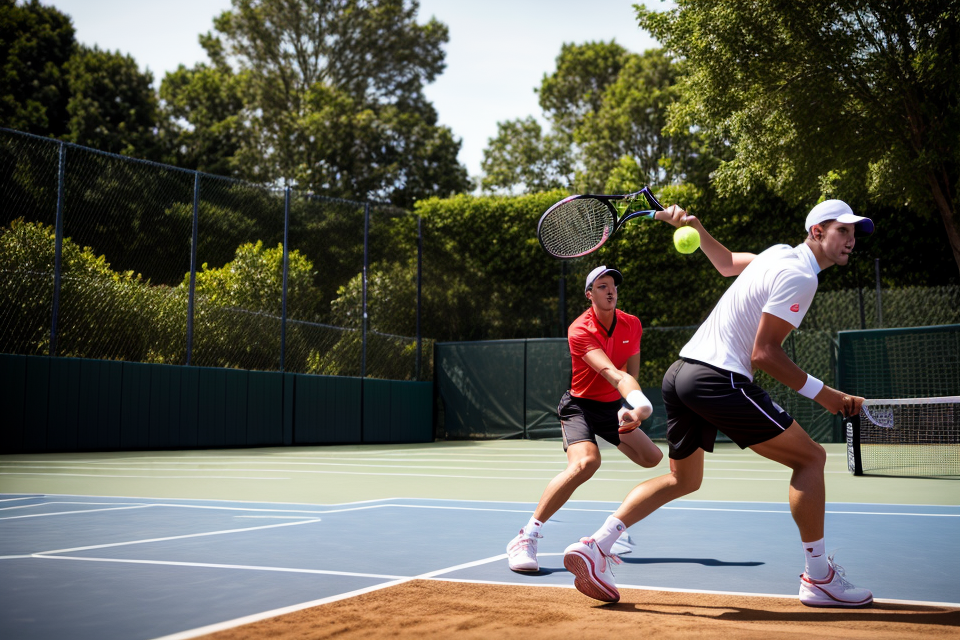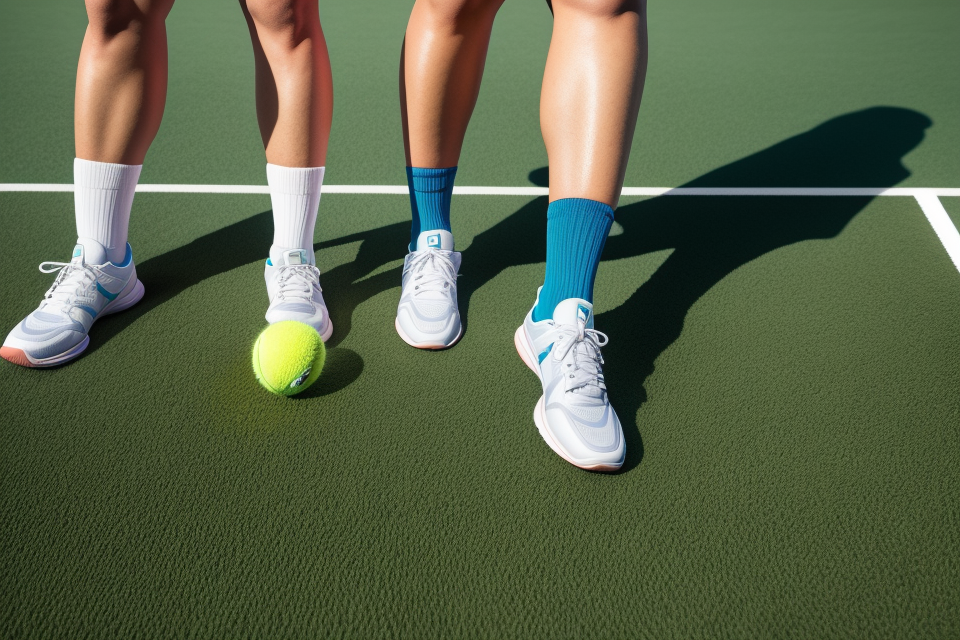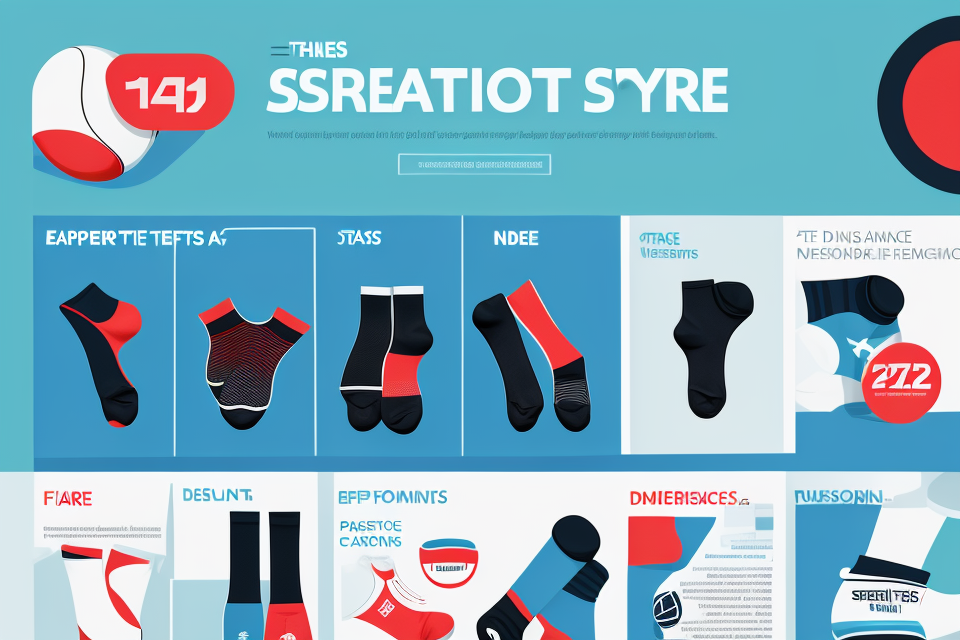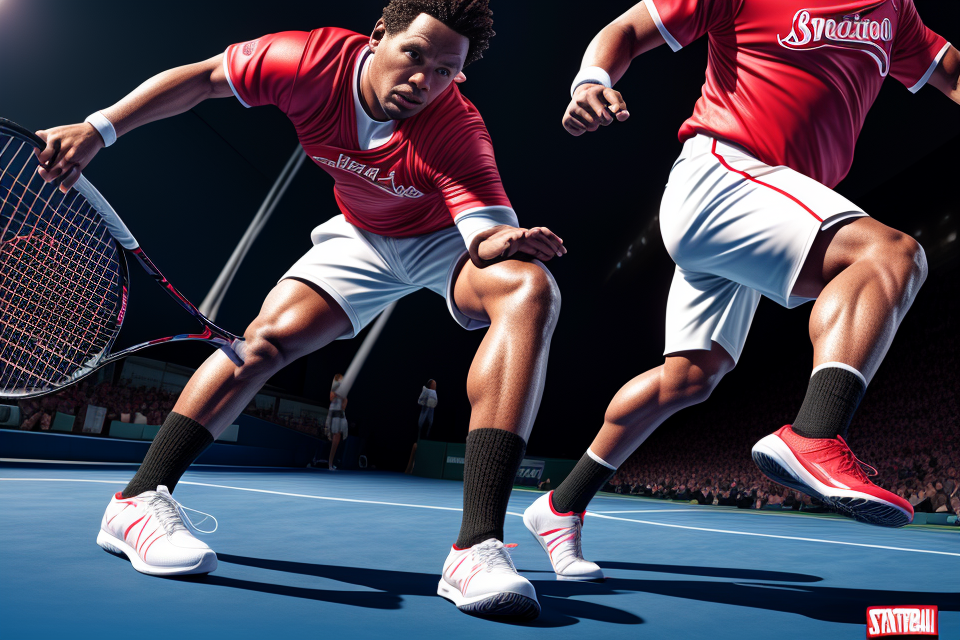When it comes to tennis, every little detail can make a difference in your performance on the court. One such detail is the type of socks you wear. While some may dismiss it as a minor aspect, others swear by the benefits of specialized tennis socks. But the question remains, do tennis socks really make a difference in your game? In this article, we’ll explore the advantages of wearing tennis-specific socks and examine the science behind their design. So, whether you’re a seasoned pro or just starting out, read on to discover how your sock choice can impact your performance on the court.
Tennis socks are designed with special features such as cushioning, arch support, and moisture-wicking properties to enhance the performance of tennis players. While some players swear by them, others may not notice a significant difference. However, wearing appropriate socks can help prevent blisters, plantar fasciitis, and other foot injuries that can affect performance on the court. So, while the difference may not be noticeable in terms of enhancing performance, tennis socks can still play an important role in maintaining foot health and preventing injuries.
The Importance of Foot Support in Tennis
Foot Anatomy and Function
The foot is a complex structure composed of 26 bones, 33 joints, and over 100 muscles, tendons, and ligaments. It is responsible for supporting the weight of the body and providing stability and balance during movement. Understanding the anatomy and function of the foot is crucial for tennis players, as it affects their ability to perform at their best on the court.
Bones, Muscles, and Arches
The foot has three main arches, which are formed by the bones and ligaments of the foot. These arches help to distribute the weight of the body evenly across the foot and provide support during movement. The bones of the foot are also connected to the muscles in the lower leg, which help to control the movement of the foot during walking and running.
Foot Strike and Shock Absorption
The way the foot strikes the ground during movement can have a significant impact on the performance of a tennis player. A proper foot strike is essential for maximizing power and efficiency during movement. Tennis players who land on their heels, known as heel strikers, are more likely to experience shock absorption and have a lower risk of injury. On the other hand, those who land on their toes, known as forefoot strikers, may have a higher risk of injury and may experience less shock absorption.
The anatomy and function of the foot play a crucial role in the performance of tennis players. Understanding the importance of foot support and how it affects movement can help players improve their game and prevent injuries.
Footwear Impact on Tennis Performance
Traction and Stability
The type of footwear worn by a tennis player can significantly impact their performance on the court. Traction and stability are two critical factors that are influenced by the shoes a player wears. A good pair of tennis shoes will provide the necessary grip and support to prevent slips and falls on the court, which can disrupt the flow of the game.
In addition to providing traction, tennis shoes also play a crucial role in maintaining stability during quick movements and changes of direction. The shoes’ design, including the materials used and the type of sole, can significantly impact a player’s ability to maintain balance and control while moving at high speeds.
A good pair of tennis shoes will also provide the necessary cushioning and support to absorb the impact of each step, reducing the risk of injury to the feet, ankles, and knees. This is especially important in a sport like tennis, where players are constantly jumping, running, and changing direction.
In conclusion, the type of footwear worn by a tennis player can have a significant impact on their performance on the court. A good pair of tennis shoes will provide the necessary traction, stability, and support to help players perform at their best.
The Science Behind Tennis Socks
Materials and Design
Moisture-Wicking Fabrics
Moisture-wicking fabrics are a key component of tennis socks, as they help to keep the foot dry and comfortable during play. These fabrics work by drawing sweat away from the foot and transporting it to the outer layer of the sock, where it can evaporate more easily. This helps to prevent the foot from becoming slippery or uncomfortable, which can be a major distraction during a match.
One type of moisture-wicking fabric that is commonly used in tennis socks is polyester. Polyester is a synthetic fiber that is known for its ability to wick moisture away from the skin quickly and efficiently. It is also highly durable and resistant to shrinking, which makes it a popular choice for sports apparel.
Another material that is often used in tennis socks is bamboo. Bamboo is a natural fiber that is known for its softness and breathability. It is also highly absorbent, which makes it effective at wicking moisture away from the foot. In addition, bamboo is a sustainable material that is gentle on the environment, which makes it a popular choice for eco-conscious athletes.
Arch Support and Compression
In addition to moisture-wicking fabrics, many tennis socks also feature arch support and compression. Arch support is designed to help stabilize the foot and reduce the risk of injury, particularly for players who spend long hours on the court. The compression element of tennis socks helps to improve blood flow to the foot, which can help to reduce fatigue and improve performance.
There are a few different types of arch support that are commonly used in tennis socks. One type is a seamless toe box, which is designed to provide support while allowing for natural movement of the foot. Another type is a cushioned midfoot area, which provides extra support and shock absorption. Finally, some tennis socks feature a heel cup, which helps to keep the heel in place and reduce the risk of slipping.
Compression is achieved through the use of tight-fitting fabric that applies gentle pressure to the foot and lower leg. This pressure helps to improve blood flow and reduce inflammation, which can help to reduce fatigue and improve performance. Compression socks are also effective at reducing the risk of injuries such as shin splints and plantar fasciitis.
Overall, the materials and design of tennis socks play a crucial role in their ability to improve performance on the court. Moisture-wicking fabrics help to keep the foot dry and comfortable, while arch support and compression help to reduce the risk of injury and improve blood flow to the foot. By choosing the right tennis socks, players can enhance their performance and enjoy a more comfortable and successful time on the court.
Benefits of Wearing Tennis Socks
Enhanced Performance
Wearing tennis socks can have a significant impact on a player’s performance. Here are some ways in which tennis socks can enhance performance:
- Support and Comfort: Tennis socks are designed to provide support and comfort for the feet during long hours of play. They have extra cushioning in the balls of the feet and arch support to reduce fatigue and help prevent blisters and other foot injuries.
- Grip and Traction: Tennis socks often have a textured or grippy surface on the bottom that helps to prevent slips and falls on the court. This can help players maintain their balance and stability during quick movements and changes of direction.
- Moisture-wicking: Tennis socks are designed to wick moisture away from the feet, keeping them dry and comfortable. This is especially important in hot and humid conditions, as wet feet can be slippery and can cause blisters and other foot problems.
Foot Health and Injury Prevention
Tennis socks can also help to prevent foot injuries and promote overall foot health. Here are some ways in which tennis socks can help:
- Arch Support: Tennis socks often have arch support built into them, which can help to reduce the risk of developing flat feet or other foot problems. This support can also help to distribute weight more evenly across the foot, reducing the risk of pain and injury.
- Blister Prevention: Tennis socks are designed to reduce the risk of blisters and other foot injuries. They often have extra padding in the areas where blisters are most likely to form, such as the balls of the feet and the heel.
- Anti-Fungal Properties: Some tennis socks are treated with anti-fungal agents to prevent athlete’s foot and other fungal infections. This can help to keep the feet healthy and prevent the need for medical treatment.
Overall, wearing tennis socks can provide a number of benefits for tennis players, including enhanced performance, foot health, and injury prevention. While the differences may be subtle, they can add up over time to make a significant impact on a player’s game.
Debunking the Myth: Are Tennis Socks Overrated?
Factors Affecting Tennis Performance
Fitness and Skill Level
The level of fitness and skill of a tennis player are among the most critical factors that affect their performance on the court. Elite players possess a high level of physical fitness, which allows them to perform at an exceptional level for extended periods. Physical fitness enables them to maintain a high level of intensity and endurance throughout the match, recover quickly from fatigue, and execute shots with precision and power.
In contrast, recreational players may struggle to maintain the same level of intensity and endurance due to their lower level of physical fitness. They may tire quickly, experience muscle cramps or injuries, and find it challenging to execute shots with the same precision and power as elite players. Improving physical fitness through regular exercise, strength training, and cardiovascular conditioning can significantly enhance a player’s performance on the court.
Court Surface and Shoe Type
The type of court surface and shoe worn by a player can also significantly impact their performance. Different court surfaces, such as hard courts, clay courts, and grass courts, require different playing techniques and footwork patterns. For example, clay courts are known for their slow surface, which requires players to adopt a low stance and use more knee bend to execute shots. In contrast, hard courts are faster and require players to use a more aggressive playing style with quick movements and powerful shots.
The type of shoe worn by a player can also affect their performance. Tennis shoes are designed with specific features such as non-marking soles, cushioning, and a flexible sole to provide support and comfort during matches. Different shoe models offer varying levels of support, stability, and traction, which can impact a player’s ability to move quickly and change direction on the court. Choosing the right shoe for the player’s playing style, foot shape, and court surface can significantly enhance their performance on the court.
Tennis Socks vs. Regular Socks
Similarities in Design and Function
Tennis socks and regular socks share some similarities in their design and function. Both types of socks are designed to provide support and cushioning for the feet during physical activity. They also feature materials that wick moisture away from the feet to keep them dry and comfortable. Additionally, both types of socks are available in a range of sizes and colors to suit individual preferences.
Differences in Durability and Comfort
Despite their similarities, tennis socks and regular socks differ in terms of durability and comfort. Tennis socks are designed to be thicker and more cushioned than regular socks, providing extra support for the feet during long hours of play. They also feature reinforced toe and heel areas to prevent wear and tear from frequent lateral movements. Furthermore, tennis socks are typically made from higher quality materials that can withstand the demands of the sport, such as polyester and nylon blends.
On the other hand, regular socks are typically thinner and less cushioned than tennis socks. They may not provide the same level of support and protection for the feet during intense physical activity. While they may be comfortable for casual wear or light exercise, they may not be suitable for sports like tennis that require rapid movements and changes in direction. Additionally, regular socks may not be as durable as tennis socks, and may wear out more quickly with frequent use.
Overall, while tennis socks and regular socks share some similarities, they differ in terms of their design, function, and durability. Tennis socks are specifically designed to meet the demands of the sport, providing extra support and protection for the feet during play. Regular socks, on the other hand, may not provide the same level of support and protection, and may not be as durable for frequent use.
Weighing the Pros and Cons
Factors to Consider Before Investing in Tennis Socks
- Comfort: One of the primary reasons tennis players wear socks is for comfort. They provide a snug fit around the foot, which can help prevent blisters and other foot injuries. Additionally, tennis socks are typically made from moisture-wicking materials that keep feet dry and cool during long matches.
- Support: Tennis socks may also offer support to the feet and legs, particularly for players who suffer from foot pain or weak ankles. Some socks feature reinforced toe and heel areas, which can provide extra cushioning and stability.
- Grip: Some tennis socks are designed with a grippy sole that helps prevent slips and falls on the court. This can be especially useful for players who wear smooth-soled tennis shoes.
Making an Informed Decision on Your Tennis Gear
- Experiment: It’s essential to experiment with different types of tennis socks to determine what works best for you. Some players may find that they prefer thin socks that allow for a more natural feel of the foot on the racquet, while others may prefer thicker socks that offer more support and cushioning.
- Budget: Tennis socks can vary widely in price, with some costing as little as $10 and others reaching $30 or more. Consider your budget when making a decision, but remember that spending more doesn’t always mean getting the best performance.
- Personal Preference: Ultimately, the decision to wear tennis socks comes down to personal preference. Some players swear by them, while others find them unnecessary. It’s essential to weigh the pros and cons and make an informed decision based on your individual needs and preferences.
FAQs
1. What are tennis socks?
Tennis socks are a type of athletic sock designed specifically for tennis players. They are typically made from moisture-wicking materials to keep feet dry and comfortable during long matches, and may also feature additional cushioning or support in key areas such as the arch or ankle.
2. Why are tennis socks different from regular socks?
Tennis socks are designed to meet the unique needs of tennis players. They are typically made from materials that wick moisture away from the foot to keep feet dry and comfortable, even during long matches. They may also feature additional cushioning or support in key areas to help with foot stability and reduce the risk of injury.
3. Do tennis socks really make a difference in performance?
While the performance benefits of tennis socks may vary from person to person, many players believe that they can make a significant difference in their on-court performance. By keeping feet dry and comfortable, tennis socks can help players maintain focus and avoid distractions caused by sweaty or uncomfortable feet. Additionally, the extra cushioning and support provided by tennis socks can help with foot stability and reduce the risk of injury.
4. What are the key features to look for in tennis socks?
When choosing tennis socks, look for materials that wick moisture away from the foot to keep feet dry and comfortable. Additional features to consider may include cushioning or support in key areas such as the arch or ankle, as well as breathable materials that promote airflow to help keep feet dry.
5. How should tennis socks fit?
Tennis socks should fit snugly but comfortably on the foot, without bunching or wrinkling. A good rule of thumb is to choose a size that is true to your shoe size, with a slightly snugger fit in the heel and arch areas to provide extra support. It’s also important to choose a sock that is not too tight, as this can cause discomfort and may even restrict blood flow.



